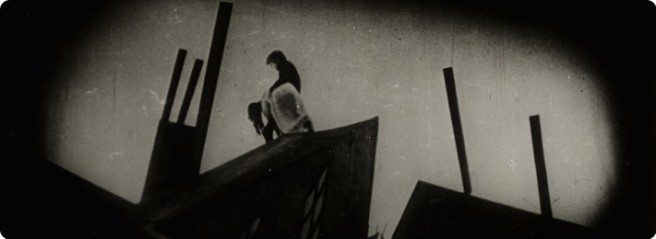The Cabinet of Dr. Caligari
Directed by Robert Weine
Germany, 1920
Cornerhouse, 10 October 2014
The angular sets are what strike you immediately, in particular the mountain view of the town, a jumble of houses looking like one of those landscapes by Schiele.
It’s an ingenious device, creating a distorted world which hints at the disturbed mental state of the (is this a plot spoiler, after almost a century?) unreliable narrator. A world at once disorientating and threatening.
There are other noteworthy aspects. As for example, the scene where Cagliari first falls on the sleepwalker who has been bought to him, his embrace openly affectionate and sexual. Also, the close-up of the monster’s face: curiously, grossly androgynous. He has a ghostly pallor, a dark heavily lipsticked mouth. And the incisive use of suggestion, a mode of storytelling that is visual yet oblique: violence as shadows wrestling upon a wall, and so on.
In other respects, the film has dated. Performances seem mannered, situations clichéd. Of course, one can recognise that this is sometimes because other, later filmmakers have borrowed and pillaged from it. At the time it must have been terrifying. Also, for a silent film, it is highly dependent on interpolated text to tell the story; it’s not a ‘pure’ example of the form.
So not exactly a classic, as Fritz Lang’s as Metropolis undoubtedly is (Lang takes his structure from music, I recall, whereas Wiene takes his from theatre – this film is in six acts. Is this significant?) but still a film that should be seen at least once. To see what later film-makers have built upon and, equally instructive perhaps, discarded.

